Car Seat Safety: Complete Guidelines
Everything You Need to Know About Child Car Seat Safety
If you’re a parent, car seat safety is probably your number one concern when driving whether you have an infant, toddler, or young child. And that concern is well founded. Car accidents are the number two cause of death for children ages 1 to 4 and the number one cause of death for children ages 4 to 12. These car seat safety guidelines were created to give you peace of mind so you can stop worrying about this issue. You will learn car seat safety, the different types of car seats, car seat installation for all types of car seats, and how to use all types of car seats. By following this car seat safety guide, you will dramatically decrease your child’s risk of death or serious injury in a car accident. In fact, according to the academy of pediatrics, a child safety seat for cars can reduce the risk of injury by up to 82% and reduce the risk of death by 28%.
CAR SEAT SAFETY RATINGS
All child restraints sold in the United States are required to meet or exceed the dynamic testing requirements of Federal Motor Vehicle Safety Standard (FMVSS) No. 213, Child Restraint Systems. So, if you purchase your car seat in America and it was manufactured by a reputable company, it should meet or exceed these minimum standards. Furthermore, car seat manufacturers have the right to advertise they meet or exceed the standards. So, if you want to be sure, you can check the manufacturers owner’s manual.
It is also important to know if a child car seat has been recalled because it is defective. The federal government does it best to identify defective car seats and recall them. Here is a list of recalled car seats.
The National Highway Traffic Safety Association, NHTSA, has tested car seats in simulated car crashes to try to determine how well car seats protect children. Unfortunately, NHTSA determined there were too many variables to create a working safety rating system for individual car seats. But NHSTA has created car seat ease of use ratings. While these ease of use ratings are not car seat safety ratings, they are still important. The idea behind the ease of use ratings is that people will use car seats more often when they are easy to use. Of course, using car seats more often should lead to increased car seat safety because death and injury rates should go down. You can find the NHSTA ease of use ratings standards here.
Just because we are not aware of any federal government car seat safety ratings, that does not mean there isn’t a way to pick the best car seat. There are several independent organizations that provide safety ratings for car seats. For example, consumer reports does its own independent car seat safety testing. You can pay for consumer reports testing here. In addition, iihs.org provides their independently tested booster seat safety ratings for free.
STATE CAR SEAT SAFETY LAWS
If your car seat was manufactured in compliance with the dynamic testing requirements of the Federal Motor Vehicle Safety Standard, you should not have to worry about whether it’s safe to use. But you should also know that car seat laws can differ somewhat between states. The state laws address things like what type of car seat must be used at each stage of a child’s life. They may also require a parent to follow the installation, weight, and height requirements of the manufacturer.
If you live in the state of Florida, you’re in luck. Because we are Tampa Florida personal injury lawyers, we know Florida law. Therefore we put together this complete guide on Florida car seat laws and seat belt laws.
For other states, there are some general overview resources that exist. For a good resource on the differences between car seat laws from state to state, check out verywellfamily.com. For a good resource for child seat belt laws from state to state check out iihs.org’s state child seat belt guide.
CAR SEAT LATCH SYSTEM
All cars manufactured after 2002 must have a LATCH (lower anchors and tethers for children) system that can be used to install a rear facing car seat. As part of the LATCH system, there are lower anchors in the back seat. These are used to attach the base of the car seat to the car. The anchors stick up in the gap where the seat backing meets the seat cushion. Here are some photos that depict the location of the lower anchors.

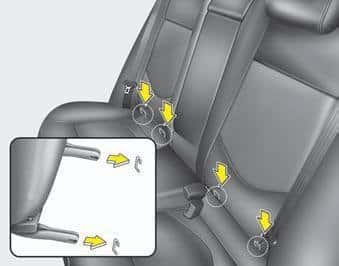
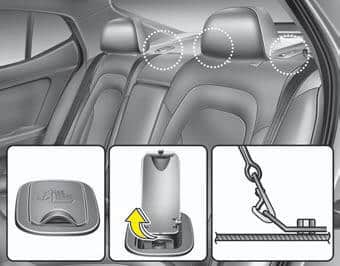
The other part of the LATCH system are the tethers. These are used to attach the top of the car seat to the car. The tether anchors are located either at the top of the rear car seat, the ceiling of the car, or the floor of the car. Here are some photos that depict using the tether.
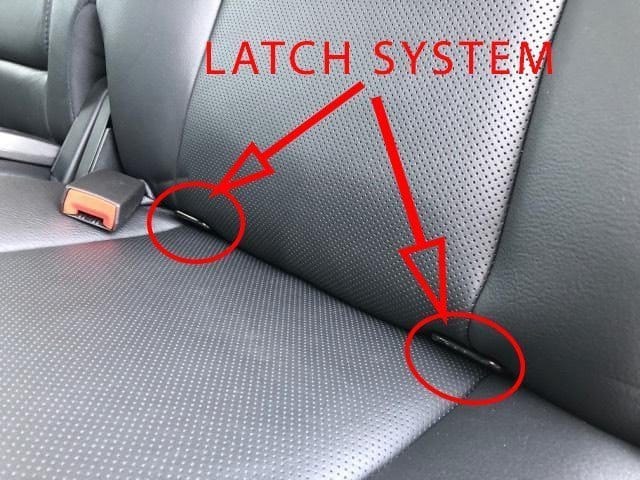
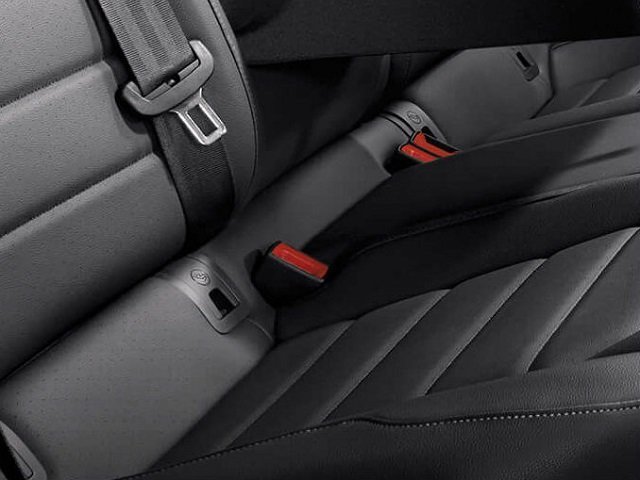
To learn more about the car seat LATCH system click on this link from thecarseatlady.com.
WHEN TO USE A SEAT BELT WITH A CAR SEAT
Most car seats today have the option of using the car seat belts instead of the lower anchors of the LATCH system. In fact, if the seat belt is used properly, it can be just as safe as using the lower anchors in the car. There are several reasons you may want to use the seat belt.
First, it’s very difficult to find the lower anchors buried in the seat.
Second, even when you find them the lower anchors, if they are buried too deeply, it may be difficult to attach the car seat straps to the lower anchors.
Third, although the LATCH system works well for smaller infants, there is some concern that with heavier children, the excess weight could cause the lower anchors to detach from the impact of a car accident. As a result, since 2014 the new LATCH rules from NHTSA require a label to warn parents that the lower anchors should not be used once the child and the car seat reach a combined weight of 65 pounds. Once the maximum weight is exceeded you can still use the tethers. But for safety reasons, you should stop using the lower anchors and use the seat belt instead.
Fourth, when your child meets the weight and height requirements for a booster seat, the seat belt is almost always used instead of the anchors and tethers.
CAR SEAT SAFETY INFANT
All infants should start out in a rear facing car seat from their very first ride home from the hospital. Rear facing car seats provide the best protection for newborns and growing infants. In addition, car seats made just for infants are generally smaller than other types of car seats. That way when you take your child home from the hospital, it will fit your child perfectly. These infant only car seats usually have a handle as well so they can act as a carrier and small cradle. But as your infant grows, different sizes and types of car seats are recommended.
The type of infant car seat to use to keep your child safe is no longer dependent on infant age. So, focusing on infant car seat age is not helpful. In other words, the age of your infant is no longer considered the important factor in finding a safe car seat. This is because infants grow and gain weight at different rates. As a result, infant weight and sometimes height are used today to determine the type of car seat to use. Therefore, looking at the infant car seat weight and height recommendations of the car seat manufacturer is a better way to find the right car seat. Many infant only car seats will carry infants up to 25 pounds
CAR SEAT SAFETY TODDLER
The word toddler is used for infants that are just beginning to walk because they toddle when they are walking. Toddlers are generally considered ages 1 to 3. In the past, when a child became a toddler, this was the time to transition an infant from a rear facing car seat to a forward-facing car seat. But the latest toddler car seat safety research indicates this transition should be delayed as long as possible. Just like infants, toddlers and young children grow at different rates. So if your asking the question, “rear facing car seat how long” you need to know there is no longer a rear facing car seat age limit. Instead, car seat manufacturers focus more on weight and height limits. This means your child may be in a rear facing car seat well past their toddler years.
If you purchased an infant only car seat when your child was born, you may need to purchase a larger rear facing car seat to fit your growing toddler. Today, car seat manufacturers are making rear facing car seats for children as large 40 pounds.
REAR-FACING CAR SEAT
A rear facing car seat is just what the name implies. When positioned properly, your child’s face will be facing the rear of the vehicle. To accomplish this, your child will lay on its back in the car seat. The car seat rests on the vehicle seat so that the bottom of your child’s feet are facing the back of the vehicle and the back of their head is facing the front of the vehicle.
The reason all infants and toddlers should use a rear facing car seat is because their bodies have not developed enough to handle the forces of an automobile accident when their body of facing forward. When a car stops suddenly in a car accident and a rear facing car seat is in use, the forward movement of the infant’s head, neck and torso will be pushed into the back of the seat instead of whip-lashing forward unprotected.
HOW TO INSTALL A REAR FACING CAR SEAT
All rear facing car seats should be placed in the back seat and not the front seat. This is in part because the front seat airbag can cause devastating damage to an infant. Furthermore, the safest back seat location is the middle of the seat. This reduces the likelihood of injury from side impact car accidents. Here are some safety tips to keep in mind:
- Read the car seat owner’s manual and instructions thoroughly before installing.
- Do not dress your infant in bulky clothing because it can compress in a car accident creating slack in the restraints that may lead to injury.
- Do not worry if your baby’s feet touch the car back of the vehicle seat. Injuries to legs are rare because babies are able to bend their legs easily.
- Do not place anything under or behind your infant unless it came with the car seat. You can place rolled blankets on either side of your infant to help prop shoulders or the head.
- All rear facing seats have angle indicators and angle adjusters. So make sure your infant is at the correct angle to prevent the head from flopping forward.
- Make sure all anchoring points and straps are tight whether you use the LATCH system or your car’s seat belt.
- Make sure the harness is snug. Test the shoulder area to make sure you cannot pinch any slack between your fingers.
- Make sure the chest clip is at the center of the chest and even with the armpits.
Installing a Rear Facing Car Seat Using the LATCH System
If your car was manufactured after 2002, it will have a LATCH system that can be used to anchor your baby’s car seat. You can learn more about the LATCH system above.
Here is a video that gives a general explanation of how to install a rear facing car seat using the LATCH system:
Installing a Rear Facing Car Seat Using the Vehicle Seat Belt
Most car seats can be installed using the car seat belt instead of the Latch system. You can learn more about when you might consider using the seat belt above.
Since every car seat is different, you will have to follow the car seat instruction manual to figure this out for your particular car seat. The most important safety tip for using the car seat belt is to make sure the seat belt locks to get a tight fit. Pull the seat belt all the way out and then slowly let it retract to ensure it is tight. This video will help you with this process:
FORWARD FACING CAR SEAT
If you are asking the question “forward facing car seat what age”, you are asking the wrong question. There is no magical age to switch from a rear facing car seat to a forward-facing car seat. Although industry experts recommend waiting as long as possible, the bottom line is that forward-facing car seat age limits do not exist. People commonly search the internet for “forward facing car seat when”. If you do, you will discover that switching your child to a forward-facing car seat depends on weight not age. The correct forward-facing car seat weight depends somewhat on the manufacturers rating for your car seat.
HOW TO INSTALL A FORWARD FACING CAR SEAT
When you are ready to switch from a rear facing car seat to a forward-facing car seat, here are some safety tips to help you make the transition:
- Install the forward-facing car seat in the vehicle back seat, preferably in the middle of the seat.
- Use either the lower anchors of the LATCH system or the vehicle safety belt but never both.
- Once the combined weight of the car seat and the child reach 65 pounds, use the vehicle seat belt and not the lower anchors of the LATCH system.
- If you are using the vehicle seat belt, make sure it is properly tightened.
- Always use the car seat top tether and tether connector of the LATCH system.
- The car seat harness should be at or above the child’s shoulders. The car seat owner’s manual should tell you the correct harness slot to use.
- The harness should lie flat and snug on the child’s shoulders without any slack.
- The chest clip of the harness should be at the child’s armpits and across the sternum.
- If your car seat has a recline setting, may sure it’s in the proper upright position recommended by the car seat manufacturer.
Installing a Forward Facing Car Seat Using the LATCH system
For a detailed explanation of the LATCH system click here. You should follow the manufacturer’s recommendations on how to install your particular car seat. But this video demonstrates generally how to install a forward facing car seat using the LATCH system:
Installing a Forward Facing Car Seat Using the Vehicle Seat Belt
You should switch from the lower anchors of the LATCH system to the vehicle seat belt when the combined weight of the child and the car seat exceed 65 pounds. You can learn more about when you might consider using the seat belt above. Because each car seat is different, follow the car seat instruction manual to figure this out for your particular car seat. Make sure the seat belt locks to get a tight fit. Pull the seat belt all the way out and then slowly let it retract to ensure it is tight. This video will help you with this process.
CONVERTIBLE CAR SEAT SAFETY
A convertible car seat can be used rear facing when your child is an infant and then switched to forward facing as your child grows. There are no convertible car seat safety ratings that are specific to convertible car seats. There are also no convertible car seat age requirements. Each manufacturer determines the age and weight for their particular car seat. Since all car seats on the market are supposed to voluntarily conform to NHTSA standards, the best convertible car seat will be the one that meets your special needs. Convertible car seats are made for consumer convenience. Here are the things to consider when deciding on whether to purchase a safe convertible car seat:
- Saves Money: Although a convertible car seat may cost more than an infant or booster seat, you don’t have to buy a second seat when your child grows. As a result, the overall cost is usually less.
- Versatility: Because the car seat grows with your child, you do not have the inconvenience of shopping for a new car seat and storing or disposing of the old one.
- Higher weight limits: The weight limits for rear facing are usually higher with convertible car seats so your child can stay in the safer rear facing position longer.
- Small car: Many convertible car seats today are specially made for small cars. So, it’s easy to find the best convertible car seat for small cars.
HOW TO INSTALL A CONVERTIBLE CAR SEAT
How to install a convertible car seat will depend on whether you are installing it rear facing or forward facing. You will install it rear facing when your child is an infant and a toddler up to the weight limit suggested by the manufacturer. You will install it forward facing when your child meets the weight limit suggested by the manufacturer to do so. Here is a video that demonstrates installing a convertible car seat first in the rear position and then in the forward position. It is a bit long but worth viewing until the end:
ALL IN ONE CAR SEAT
An all in one car seat is designed to be the only car seat you ever buy. It starts out rear facing. Each of them has their own way of making sure your new born will fit as well as your growing baby. Once your baby hits the rear facing weight limit it can be turned around to act as a forward facing car seat. The all in one car seat differs from the convertible car seat in that it can also act as a booster seat for older children. There are no safety ratings specific to all in one car seats. There are also no all in one car seat age requirements. Each manufacturer decides the age and weight for their particular car seat. Since all car seats on the market are supposed to voluntarily conform to NHTSA standards, the best all in one car seat will be the one that fits your lifestyle. All in one car seats are made for consumer convenience. You should consider these things when deciding on whether to purchase an all in one car seat:
- All in one car seats are meant to stay in the car. So you will need a separate stroller and baby carrier.
- All in one car seats are usually larger and bulkier than other car seats. So you if you have a smaller car, it may not fit.
- All in one car seats are usually much heavier than other car seats. So if you are planning to remove it from the car on a regular basis, this may not be the best choice for you.
- All in one car seats usually do not come with built in carry handles.
HOW TO INSTALL AN ALL IN ONE CAR SEAT
Every all in one car seat is different. So you will have to refer to the owner’s manual for the car seat you want to buy to get specific instructions. But there are many similarities. This video on how to install a GRACO 4EVER CAR SEAT will give you the basics. It will also help you decide whether an all in one is right for you.
BOOSTER SEAT SAFETY
The most important booster seat safety issue is when to make the move. At some point your child will outgrow a car seat but will be too small to sit in a vehicle car seat. For children in this in between age, it’s not safe for them to ride in a rear facing or forward facing car seat because they are too big. But it’s also not safe for them to ride in the vehicle seat with just a seat belt because they are too small. The booster seat bridges this gap. The child sits on the booster but uses the vehicle safety belt. The booster raises the child up so the vehicle safety belt fits properly across the child’s chest between the shoulder and the neck without touching the neck.
For safety reasons, you should not move your child to a booster seat until your child has grown big enough to do so. Because all children grow and develop differently, there is no set booster seat age requirements or age limit. You will know when it is time for safety reasons to make the transition to a booster seat when your child reaches the following milestones:
- Your child reaches the top weight and height allowed listed in the instruction manual for the forward facing car seat you are using.
- Your child’s shoulders are above the top harness slots of your forward facing car seat.
- Your child is between 40 and 80 pounds and at least 35 inches tall.
TYPES OF BOOSTER SEATS
There are two basic types of booster seats. The first type is a high back booster seat. The second type is a backless booster seat. Just like all the other car seats, there is no high back booster seat age requirements or backless booster seat age requirements. But there are reasons to use one or the other.
High Back Booster Seat
A high back booster seat has a full back and head rest. It must be used in a vehicle that has a back seat that does not come up to your child’s ears. The high back helps prevent whiplash in a car accident.
Backless Booster Seat
A backless booster seat has a seat cushion and arm rests but does not have a back. The backless booster seat is usually preferred by older children because it makes them feel less babyish.
HOW TO USE A BOOSTER SEAT
There is a right way and a wrong way to use a booster seat. These booster seat safety tips should help you figure it out:
- Children under 13 should always ride in the back seat
- Always use both the shoulder and lap part of the seat belt
- Never place the lap portion of the seat belt behind your child’s back or under their arm. If the lap belt is rubbing on your child’s neck, they may be too short for a booster seat or you may need a different booster seat
- Follow the safety seat instructions manual for the booster seat you own.
- The lap belt should be snug across your child’s upper thighs.
- The shoulder belt should rest across your child’s chest between the neck and the shoulder but not touching the neck.
Here is a video that demonstrates how to use a booster seat:
WHEN IS IT SAFE TO STOP USING A BOOSTER SEAT
At some point your child may feel embarrassed to still be using a booster seat when others are not doing so. Don’t give in to peer pressure. Transitioning your child to a vehicle car seat without a booster seat too soon can lead to severe injuries and even death in a car accident. The transition should not occur until your child reaches at least 4 feet 9 inches tall and at least 8 years old. Many children do not reach this height requirement until they are 12.
CAR SEAT INSTALLATION CHECK LOCATIONS
3 out of 4 car seats are improperly installed. watching installation videos can help improve your odds of getting it right. But having a car seat safety check done by a professional can give you peace of mind. You may be able to find a car seat technician to perform an installation check by visiting the National Child Passenger Safety program. You may also be able to find a car seat safety check event near you by visiting a safe kids event near you. If that does not work then call or visit your local police or fire station to see if they can help. If not then try searching on the internet for “Car Seat Installation Near Me”.
CAUSES OF CHILD CAR SEAT INJURY
The number one cause of injury to children in car seats is the failure to install the car seat properly. If you follow the information is this safety guide, this should not happen to you or your child. But the possibility does exist that a child safely secured in a car seat can be injured in a car accident because the car seat is defective. The most common car seat defects are:
- Low quality straps and or buckles that tear too easily
- Highly flammable materials
- Faulty strap adjusters that become loose on their own over time
- Faulty or weak frames that easily break on impact
- Connectors that break or come undone from the LATCH anchors
How to Prevent Car Seat Injury
There are many things you can do to substantially reduce the risk your child will be injured in an automobile accident. Here is a list of things we recommend:
- Make sure you never purchase a second hand or used car seat. This is because you do not know that car seat’s history. For example, it may have been in a crash that causes it to have a hidden defect, it may be older than its manufacturers recommended expiration date, or it may be on recall.
- Register your newly purchased car seat with the manufacturer. This will ensure you are notified of any defects that are later discovered. It will also ensure you are notified of any recalls that occur. You can also monitor this NHTSA website page for recalls.
- Thoroughly study this guide and your car seat manual, so you learn how to properly install the car seat you purchase.
- Make sure you follow the weight and height limits of your car seat and timely progress your child to the next type of seat when the time comes.
Our auto accident lawyers in Tampa believe the best car seats are the ones that consumers that actually use the car seats rate the highest. We have put together a list of different types of car seats that have high ratings from consumers. Although we are not recommending you purchase any particular car seat listed below, we hope you find these consumer car seat ratings helpful.

Graco 4ever 4-in-1 Convertible Car Seat
4.7 Stars Based on 1,000+ Reviews – For use from 4-65 lbs
Graco 4Ever 4-in-1 Convertible Car Seat gives you 10 years with one car seat. It’s comfortable for your child and convenient for you, transitioning from rear-facing infant car seat (4-40 lb) to forward-facing 5-point harness seat (22-65 lb) to high-back belt-positioning booster (30-100 lb) to backless belt-positioning booster (40-120 lb). For a proper fit, the Simply Safe Adjust Harness System and 10-position headrest let you adjust the harness and headrest together, with no re-threading. The 6-position recline keeps your child comfortable, the Fuss Free harness makes it easy to get your child in and out, and the In Right LATCH system, with one-second attachment, makes installation easy. It’s the only seat that truly goes from baby to booster! Machine-washable seat cushion. Metal and plastic parts may be cleaned with mild soap and cool water. Buckle may be cleaned with a damp cloth.

Chicco KeyFit 30 Infant Car Seat
4.8 Stars Based on 400+ Reviews – For use from 4-30 lbs
The Chicco KeyFit 30 Infant Car Seat is engineered with innovative features that make it the easiest infant car seat to install simply, accurately, and securely every time. The KeyFit 30’s stay-in-car base has a ReclineSure leveling foot and two RideRight bubble level-indicators to help achieve and verify proper angle in the vehicle seat. The base is also equipped with premium LATCH connectors and a SuperCinch tightener for a secure fit with a fraction of the effort. This car seat carrier includes removable head and body support to accommodate newborns as small as 4 pounds. A five-point harness with one-pull tightening helps keep baby secure, and the carrier shell is lined with EPS energy-absorbing foam for improved impact protection. An adjustable, removable canopy provides shade from the sun.
The KeyFit 30 is designed for travel system use with compatible strollers from Chicco. The carrier secures easily to the base and strollers with a reassuring audible click. A two-position carry-handle and one-hand release make it just as easy to remove.
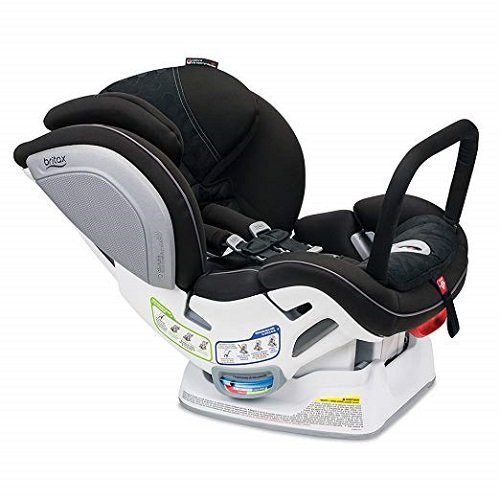
Britax Advocate ClickTight Anti-Rebound Bar Convertible Car Seat
4.1 Stars Based on 100+ Reviews – For use from 5-65 lbs
The Advocate ClickTight convertible car seat has the patented ClickTight Installation System, Anti-Rebound Bar, three layers of side impact protection, Click & Safe Snug Harness Indicator, and SafeCell Impact Protection for peace of mind while you’re on the go with your child. The Anti-Rebound Bar minimizes forces associated with crashes by stabilizing the car seat when installed rear-facing. Car seat installation is easy as buckling a seatbelt thanks to the ClickTight Installation System. The 14-position easy-adjust harness grows along with your child and you can change the height of the seat with just the push of a button – no re-threading necessary. Have peace of mind knowing your child’s harness is within range of proper tightness. With the sound of a click thanks to the Click & Safe Snug Harness Indicator you will know it’s correctly adjusted. The Advocate car seat can be used rear-facing 5-40 pounds and forward-facing 20-65 pounds, child standing height 49” or less.
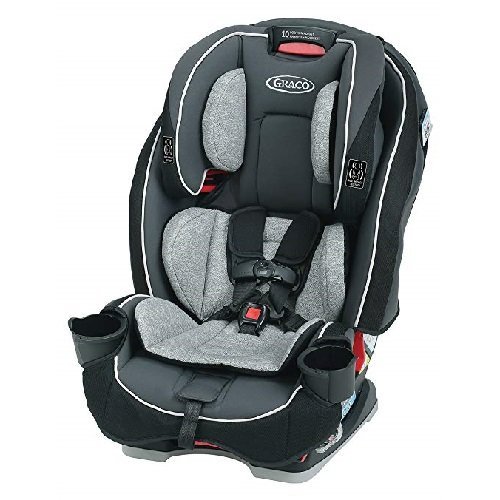
Graco SlimFit 3-in-1 Convertible Car Seat
4.8 Stars Based on 600+ Reviews – For use from 5-100 lbs
The Graco SlimFit seat saves space in your backseat, while giving your child plenty of room to grow! The unique, rotating cup holders simply rotate away, making the seat 10% slimmer to save precious back seat space. It’s a rear-facing (5-40 lb) and forward-facing (22-65 lb) car seat, as well as a belt-positioning booster (30-100 lb). The Simply Safe Adjust Harness System means you can easily adjust the harness and headrest together, to accommodate your growing child with ease. With 4-recline positions, you can keep your child comfortable, while the InRight Latch system makes installation easy with a one-second attachment. With all these great benefits, in a sleek space saving design, the SlimFit is the perfect car seat!
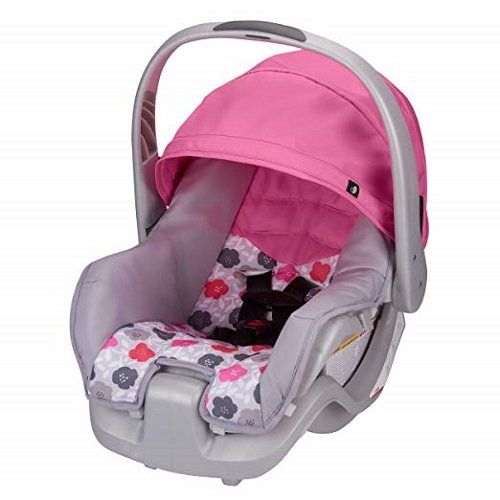
Evenflo Nurture Infant Car Seat
3.9 Stars Based on Under 100 Reviews – For use from 5-22 lbs
Specifically for infants – convenience for you and comfort for baby. The Evenflo Nurture Infant Car Seat provides comfort for your child and exclusive convenience for the ultimate value in child restraints. The Nurture Infant Car Seat features an ergonomically shaped handle for a more comfortable carry and a pivoting canopy, to shade your baby. This seat can be used rear-facing only for children weighing 5 – 22 pounds. This seat may be used with or without a base. Additional accessory bases available.
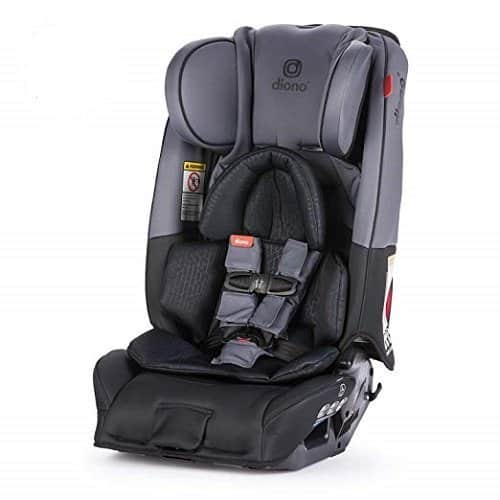
Diono Radian 3RXT All-in-one Convertible Car Seat
4.4 Stars Based on 300+ Reviews – For use from 5-120 lbs
Enjoy the journey with our Diono Radian 3RXT all-in-one convertible car seat, lovingly engineered to always overprotect. Your child’s safety is our top priority, with premium, innovative features the Diono Radian 3RXT is sleek and stylish with all the practicalities that you could possibly need like a steel alloy frame, aluminum reinforced side walls, energy absorbing EPS foam, and memory foam to put your mind at ease as your little one travels safely in style and comfort. The reinforced adjustable head support provides additional side impact protection. And, if you want to avoid those bulky car seats, look no further as the sleek design of the Diono Radian 3RXT allows for a 3-across fit or plenty of room for passengers. We’ve thought of everything so you don’t have to.
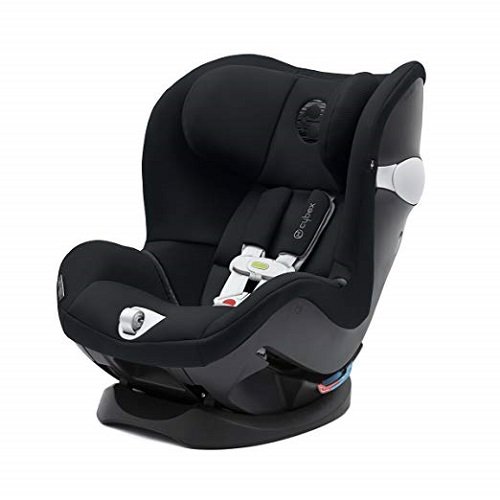
CYBEX Sirona M SensorSafe 2.0 Car Seat
3.8 Stars Based on Under 100 Reviews – For use from 5-65 lbs
The Sirona M with SensorSafe 2.0 is engineered and designed to provide peace of mind when you drive… and when you arrive. A 2018 Best of Baby Tech Award Winner for Safety, the Sirona M with SensorSafe 2.0 integrates industry-first smart-tech safety features into the chest clip of the car seat’s 5-point safety harness. Originally developed to prevent the rising number of infant hot car deaths, SensorSafe 2.0 goes a step further, alerting through the vehicle receiver and the caregiver’s cell phone when:
‣ A child is accidentally left behind in the car
‣ A child unbuckles themselves while the vehicle is in motion
‣ A child has been seated in the car too long
‣ The back seat becomes too hot or too cold
‣ SensorSafe 2.0 also provides guidance on installation, how-to videos, FAQ’s and more all through a user-friendly smartphone app.
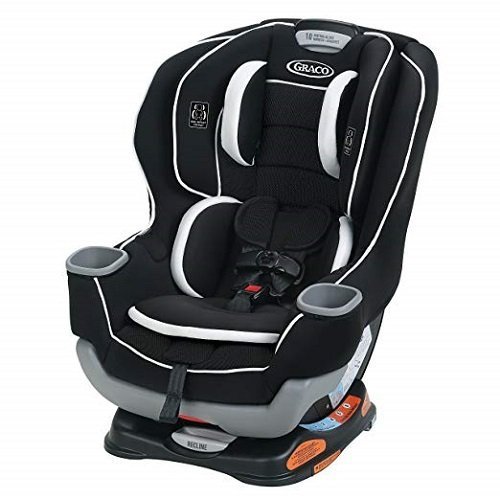
Graco Extend2Fit Convertible Car Seat
4.6 Stars Based on 3,700+ Reviews – For use from 4-65 lbs
The American Academy of Pediatrics recommends children ride rear-facing until at least 2 years of age. The Extend2Fit convertible car seat features a 4-position extension panel that provides 5″ of extra legroom allowing your child to safely ride rear-facing longer. The seat can be used rear-facing from 4-50 lb and forward-facing from 22-65 lb The seat features Simply Safe Adjust which allows you to adjust the height of the harness and headrest as your child grows, In Right LATCH for a one-second LATCH attachment and Fuss Free harness storage which holds the buckle out of the way, so it’s easy to get baby in and out.
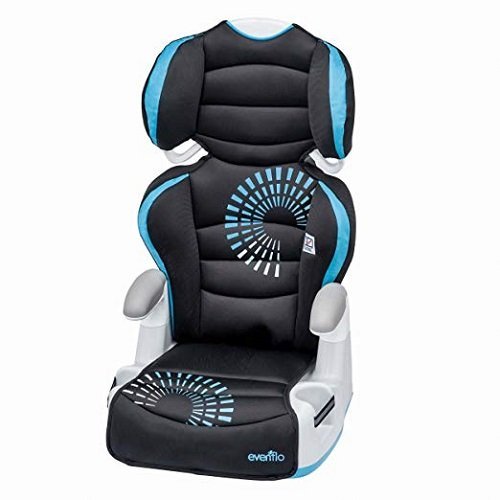
Evenflo Big Kid AMP Booster Car Seat
4.6 Stars Based on 5,300+ Reviews – For use from 40-110 lbs
The Evenflo Big Kid Amp Booster Car Seat gets your child excited about sitting in a booster seat! With 6 height positions, the back adjusts as your child grows, keeping the side and head support in the proper position. It also transitions into a no-back booster. Your child will love the comfortable padding around the head and body. Elastic cup holders are perfect for a juice box or a quick snack.
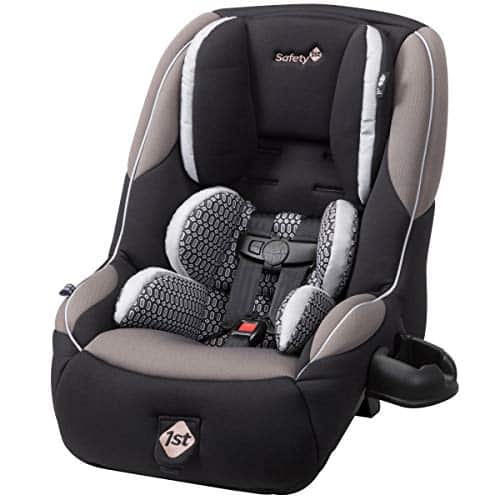
Safety 1st Guide 65 Convertible Car Seat
4.1 Stars Based on 1,300+ Reviews – For use from 5-65 lbs
Choose the guide 65 convertible car seat by safety 1st for a perfect fit in your smaller car or leave even more room in your larger vehicle. The guide 65 helps you keep your child protected longer in both rear and forward-facing positions. Rear-facing, this car seat keeps them comfortable up to 40 pounds. Change the seat to a forward-facing position once they’re ready, and they’ll be snug in the 5-point harness all the way to 65 pounds. You’ll appreciate the side impact protection and the premium fabrics that help keep them safe and comfortable in both modes of use. 2 modes of use: rear-facing 5-40 pounds and 19″-40″. Forward-facing 22-65 pounds and 34″-52″. Compact design for small cars. 5-point harness with center front adjust. 5 harness heights and 3 buckle locations for proper fit. Side impact protection. Multi-position adjustable head rest for growing children. Removable cup holder. Premium fabrics.

As an ethical and trusted personal injury lawyer, Scott Distasio founded Distasio Law Firm in February of 2006, which focuses on all types of personal injury cases. He wanted to open a law firm that represented his belief that all firms should provide ethical and outstanding service to their clients.



